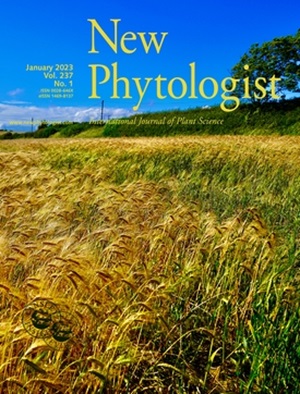aim1依赖性的高基水杨酸积累调节水稻气孔孔径
IF 8.3
1区 生物学
Q1 PLANT SCIENCES
引用次数: 1
摘要
水杨酸(SA)的基础水平在不同的植物种类之间差异很大。例如,在茎部中,水稻的SA含量几乎是拟南芥的100倍。尽管SA的基础含量很高,但水稻中SA的生物合成途径和生物学功能都没有得到很好的了解。结合代谢物分析、生理学和遗传学方法,我们发现水稻茎部基础SA的合成依赖于OsAIM1,该基因编码苯丙氨酸解氨酶(PAL)途径中的β -氧化酶。在Osaim1突变体中SA积累受损导致茎温低于野生型植株。然而,这种梢温缺陷是由于突变体稳态气孔孔径增大导致蒸腾作用增加所致。此外,OsWRKY45的持续表达需要较高的基础SA水平来调节水稻稳态气孔孔径和茎温。综上所述,这些结果为PAL通路在水稻高基础水平SA的生物合成中发挥关键作用提供了直接的遗传证据,PAL通路在调控稳态气孔孔径以促进胁迫条件下的适应度中发挥重要作用。本文章由计算机程序翻译,如有差异,请以英文原文为准。
AIM1-dependent high basal salicylic acid accumulation modulates stomatal aperture in rice
- The basal levels of salicylic acid (SA) vary dramatically among plant species. In the shoot, for example, rice contains almost 100 times higher SA levels than Arabidopsis. Despite its high basal levels, neither the biosynthetic pathway nor the biological functions of SA are well understood in rice.
- Combining with metabolite analysis, physiological, and genetic approaches, we found that the synthesis of basal SA in rice shoot is dependent on OsAIM1, which encodes a beta-oxidation enzyme in the phenylalanine ammonia-lyase (PAL) pathway.
- Compromised SA accumulation in the Osaim1 mutant led to a lower shoot temperature than wild-type plants. However, this shoot temperature defect resulted from increased transpiration due to elevated steady-state stomatal aperture in the mutant. Furthermore, the high basal SA level is required for sustained expression of OsWRKY45 to modulate the steady-state stomatal aperture and shoot temperature in rice.
- Taken together, these results provide the direct genetic evidence for the critical role of the PAL pathway in the biosynthesis of high basal level SA in rice, which plays an important role in the regulation of steady-state stomatal aperture to promote fitness under stress conditions.
求助全文
通过发布文献求助,成功后即可免费获取论文全文。
去求助
来源期刊

New Phytologist
生物-植物科学
自引率
5.30%
发文量
728
期刊介绍:
New Phytologist is an international electronic journal published 24 times a year. It is owned by the New Phytologist Foundation, a non-profit-making charitable organization dedicated to promoting plant science. The journal publishes excellent, novel, rigorous, and timely research and scholarship in plant science and its applications. The articles cover topics in five sections: Physiology & Development, Environment, Interaction, Evolution, and Transformative Plant Biotechnology. These sections encompass intracellular processes, global environmental change, and encourage cross-disciplinary approaches. The journal recognizes the use of techniques from molecular and cell biology, functional genomics, modeling, and system-based approaches in plant science. Abstracting and Indexing Information for New Phytologist includes Academic Search, AgBiotech News & Information, Agroforestry Abstracts, Biochemistry & Biophysics Citation Index, Botanical Pesticides, CAB Abstracts®, Environment Index, Global Health, and Plant Breeding Abstracts, and others.
 求助内容:
求助内容: 应助结果提醒方式:
应助结果提醒方式:


